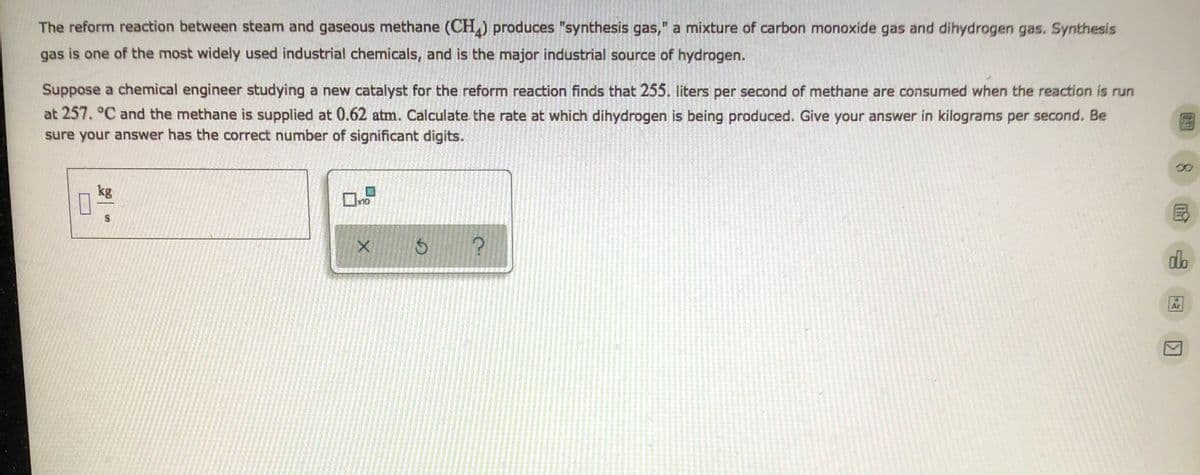The reform reaction between steam and gaseous methane (CH,) produces "synthesis gas," a mixture of carbon monoxide gas and dihydrogen gas. Synthesis gas is one of the most widely used industrial chemicals, and is the major industrial source of hydrogen. Suppose a chemical engineer studying a new catalyst for the reform reaction finds that 255. liters per second of methane are consumed when the reaction is run at 257. °C and the methane is supplied at 0.62 atm. Calculate the rate at which dihydrogen is being produced. Give your answer in kilograms per second. Be sure your answer has the correct number of significant digits. kg do
The reform reaction between steam and gaseous methane (CH,) produces "synthesis gas," a mixture of carbon monoxide gas and dihydrogen gas. Synthesis gas is one of the most widely used industrial chemicals, and is the major industrial source of hydrogen. Suppose a chemical engineer studying a new catalyst for the reform reaction finds that 255. liters per second of methane are consumed when the reaction is run at 257. °C and the methane is supplied at 0.62 atm. Calculate the rate at which dihydrogen is being produced. Give your answer in kilograms per second. Be sure your answer has the correct number of significant digits. kg do
Introductory Chemistry: An Active Learning Approach
6th Edition
ISBN:9781305079250
Author:Mark S. Cracolice, Ed Peters
Publisher:Mark S. Cracolice, Ed Peters
Chapter4: Introduction To Gases
Section: Chapter Questions
Problem 67E: The compression ratio in an automobile engine is the ratio of the gas pressure at the end of the...
Related questions
Question

Transcribed Image Text:The reform reaction between steam and gaseous methane (CH) produces "synthesis gas," a mixture of carbon monoxide gas and dihydrogen gas. Synthesis
gas is one of the most widely used industrial chemicals, and is the major industrial source of hydrogen.
Suppose a chemical engineer studying a new catalyst for the reform reaction finds that 255. liters per second of methane are consumed when the reaction is run
at 257. °C and the methane is supplied at 0.62 atm. Calculate the rate at which dihydrogen is being produced. Give your answer in kilograms per second. Be
sure your answer has the correct number of significant digits.
kg
do
Ar
Expert Solution
This question has been solved!
Explore an expertly crafted, step-by-step solution for a thorough understanding of key concepts.
Step by step
Solved in 2 steps with 2 images

Knowledge Booster
Learn more about
Need a deep-dive on the concept behind this application? Look no further. Learn more about this topic, chemistry and related others by exploring similar questions and additional content below.Recommended textbooks for you

Introductory Chemistry: An Active Learning Approa…
Chemistry
ISBN:
9781305079250
Author:
Mark S. Cracolice, Ed Peters
Publisher:
Cengage Learning

Chemistry for Engineering Students
Chemistry
ISBN:
9781337398909
Author:
Lawrence S. Brown, Tom Holme
Publisher:
Cengage Learning

Chemistry
Chemistry
ISBN:
9781305957404
Author:
Steven S. Zumdahl, Susan A. Zumdahl, Donald J. DeCoste
Publisher:
Cengage Learning

Introductory Chemistry: An Active Learning Approa…
Chemistry
ISBN:
9781305079250
Author:
Mark S. Cracolice, Ed Peters
Publisher:
Cengage Learning

Chemistry for Engineering Students
Chemistry
ISBN:
9781337398909
Author:
Lawrence S. Brown, Tom Holme
Publisher:
Cengage Learning

Chemistry
Chemistry
ISBN:
9781305957404
Author:
Steven S. Zumdahl, Susan A. Zumdahl, Donald J. DeCoste
Publisher:
Cengage Learning

Chemistry: An Atoms First Approach
Chemistry
ISBN:
9781305079243
Author:
Steven S. Zumdahl, Susan A. Zumdahl
Publisher:
Cengage Learning


Chemistry: The Molecular Science
Chemistry
ISBN:
9781285199047
Author:
John W. Moore, Conrad L. Stanitski
Publisher:
Cengage Learning